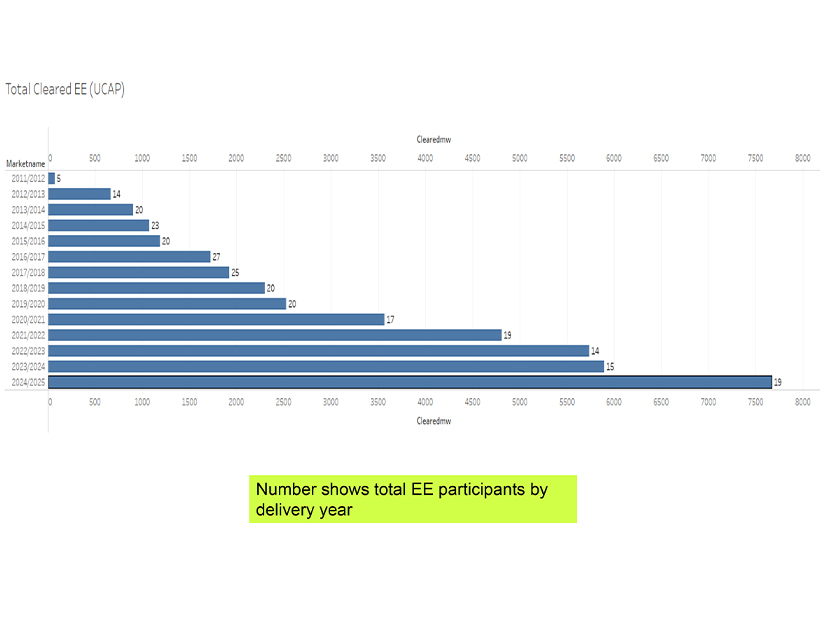
PJM Steams Ahead with CIFP Filing Timeline After FERC Deficiency Notices
Deficiency notices FERC issued on two filings PJM made to overhaul its capacity market are not expected to interrupt the RTO’s plan to implement the changes in time for the 2025/26 Base Residual Auction (BRA) scheduled for June 2024 (ER24-98, ER24-99).
PJM Associate General Counsel Chen Lu told the Market Implementation Committee that the RTO will not seek any changes to the auction timeline, which was delayed by a year in June 2023. (See PJM Files Capacity Market Revamp with FERC.)
The deficiency notices reset the 60-day deadlines for FERC to act on PJM’s requests to two months after the RTO’s responses. PJM replied to the notice in ER24-99 on Dec. 1, resulting in a Jan. 30 deadline, and submitted a response in ER24-98 on Dec. 8, carrying a Jan. 6 deadline for the commission.
Lu said staff considered seeking another delay but determined that the pre-auction activities that will be conducted before the commission’s deadlines would not be affected by PJM’s proposals and can be run while the dockets are in limbo.
Stakeholders Begin Review of Energy Efficiency Resources
Stakeholders endorsed an issue charge to revisit how energy efficiency (EE) resources participate in the capacity market and began work on identifying stakeholder interests. The document states that its goal is to make EE market participation more effective by improving resource qualifications. Key work activities include eliminating any ambiguity around what qualifies as an EE resource and ensuring that energy savings attributed to resources are “unbiased, accurate and reasonably consistent across providers.”
Luke Fishback of Affirmed Energy said EE providers are concerned that the scope of the issue charge is ambiguous and would prefer more specificity.
Stakeholders discussed whether it was necessary to include a sentence specifying that a partial solution may be advanced sooner than the expected nine-month timeline. PJM’s Pete Langbein said the language was included to leave the door open to implementing changes in time for the 2025/26 BRA in June 2024.
Several stakeholders argued that the language was redundant, because issue charge timelines do not dictate when solutions may be advanced. The line was struck from the issue charge prior to its approval.
Initiating the education process of the work, PJM’s Tim Bachus said the value of an EE resource is based on the incremental amount of energy reduction above what is required by local building codes.
Stakeholders contributing to the interest identification list added avoiding payments for energy efficiency upgrades that would naturally occur, accounting for a “rebound effect” to ensure consumer behavior doesn’t undo EE benefits and allowing EE to be eligible for the useful life of the installation.
MIC Chair Foluso Afelumo said the next meeting will continue the education and issue identification processes.
Temporary Exceptions Supplant Real Time Values
PJM’s Lauren Strella Wahba outlined how the RTO plans to implement the process FERC approved on Nov. 30 for resources to submit temporary exceptions from their unit-specific parameters. The temporary exceptions replace the real-time values process PJM maintained for resources to reflect changes to their ability to operate according to their parameters during the operating day. The commission’s order approving temporary exceptions was effective Nov. 30.
Documentation of why a resource is seeking an exception must be submitted to PJM and the Independent Market Monitor within three days.
Strella Wahba said PJM is working on updating its Markets Gateway software to reflect the changes, with updates beginning over the next few days and expected to be complete by the second quarter of next year. In the meantime, real-time temporary exceptions can be submitted using the real-time values drop-down menu.
Dominion’s Jim Davis said the addition of temporary exceptions will improve resources’ ability to keep PJM updated of any issues experienced during strained system conditions and alleviate some of the incongruities between the electric and natural gas markets.
“It’s certainly a first step to allow resources to reflect their capabilities, especially during these extreme events … and it’s also a first step for addressing the challenges around electric-gas coordination,” he said.
Migration from eDART to Account Manager Nearly Complete
PJM’s Chidi Ofoegbu urged market participants to ensure that they have completed the transfer of their eDART accounts to the new Account Manager software before Dec. 13, when eDART access will be revoked.
She also encouraged users to begin working in Account Manager prior to Dec. 13 to build up familiarity and give time to work with PJM to resolve any issues before eDART access is terminated.
Several stakeholders encouraged their peers to take the software change seriously, stating that it would be difficult for any market participant to conduct business and meet their obligations without having access to PJM’s online tools.



